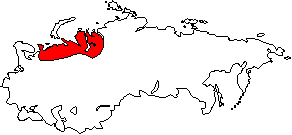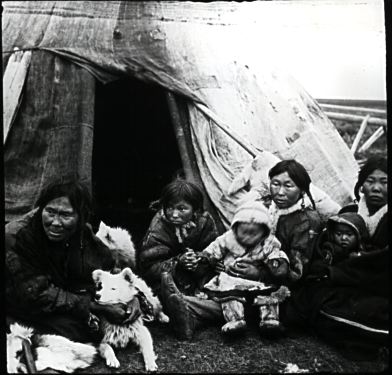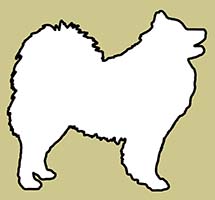The Nenets

The self-designation is Nenets (n’enyts, pl. n’enytsja), meaning ‘man’; the native term for the language is n’enytsia vada. The name hasaba, ‘man’, is less common andhas restricted usage. Etymologically, Nenets derives from the same origin as Nganasan and Enets. The primal meaning of the root nenay is ‘true, real, genuine’, and this is often used in conjunction with the self-designation n’enay nenyts — ‘Nenets, .e. a genuine man’ (cf. eney enet — ‘Enets’ and ngano nganasan — ‘Nganasan’). The term originally used by the Northern Nenets was applied to the whole people in the1920s.
The older and more widespread name for the Nenets is Yurak-Samoyeds, or simply Yuraks. This comes from a Zyryan Komi word yaran denoting the Samoyeds, which in its turn is probably derived from the Yamal Peninsula tundra family name Yar. Through the Russian language the term Yurak-Samoyeds has been established in other languages and it is in common use up to the present day outside the Soviet Union. The common term Samoyed probably derives from the Selkup language where samatu ~ somatu denoted the Enets. This probably has its origins with the Enets Madu-tribe, who were called samatu or somaut by their neighbours.
Monk Nestor of Kiev in his chronicle A Tale of the Times Past refers to the Samoyeds as neighbours and allies of the Ugrians. In 1787 the tribe name Hasaba was used by the missionary J. S. Vater in his fable Vada Hasovo (The Language of the Nenets).
Habitat. The Nenets live in the polar regions of northeastern Europe and northwestern Siberia from the Kanin Peninsula on the White Sea to the Yenisey delta, occupying the central place among the Samoyed territories. They also inhabit the Arctic Ocean islands and the Kola Peninsula. Administratively, their habitat is divided between the Nenets Autonomous District of the Arkhangelsk Region and the Yamal-Nenets Autonomous District of the Tyumen Region. Combined, this covers a vast territory of about 1 million square kilometres. A part of the Nenets also inhabits the Taymyr, or Dolgan-Nenets Autonomous District belonging to the District of Krasnoyarsk. The native land of the Nenets is the tundra and forest tundra, a country of permafrost, numerous rivers and vast marshy areas. Along the banks of the River Ob the Nenets settlements reach the dense forest area of the Siberian taiga.
Population. The Nenets are the most numerous of the Samoyed peoples — this is clearly shown by the census results:
| Year | Population | Native Speakers |
| 1897 | 9,427 (incomplete) | |
| 1926 | 17,560 | |
| 1959 | 23,007 | 84.7% |
| 1970 | 28,705 | 83.4% |
| 1979 | 29,894 | 80.4% |
| 1989 | 34,665 | 77.1% |
As the total population of the Samoyeds is about 40,000, the Nenets, as can be seen, form a substantial part. While the population shows a tendency towards increase, the data shows a decline in native language speakers. Thus the Nenets are not in danger of physical extinction but cultural. The percentage of Nenets within the total populations of their native regions is also decreasing. For example, the total population of the Yamal-Nenets Autonomous District has increased six-fold in only 19 years, from 80,000 in 1970 to 486,000 in 1989.
Anthropologically, the Nenets are representatives of the Uralic race with stronger than average Mongoloid characteristics. They are commonly of short stature (the average male height is 158 cm) and a stocky build. The face is broad and flat, with a short and somewhat protruding nose. While hair is straight and thick, beard growth is poor. Eyelids commonly exhibit epicanthic folds. Due to dark pigmentation, hair and eyes are black or brown and the skin is swarthy. In appearance the Nenets resemble most the Ostyaks, displaying, however, more Mongoloid characteristics. The Nenets of the Arkhangelsk region exhibit a somewhat stronger European strain.

Photo credit: Fridtjof Nansen (1861-1930)
The language of the Nenets belongs to the Samoyedic branch of the Uralic languages, comprising together with the Enets and Nganasan languages its Northern Group. Due to a rather low density of population spread over a vast territory the language is rich in dialects. An overwhelming majority (about 95 %) speak the Tundra Dialect that divides into 11 local vernaculars (Western, Central, and Eastern). The most prominent among these is the Bolshaya Zemlya local vernacular, which served as a basis for the Nenets written language. The Forest or Taiga Dialect divides into Western and Eastern vernaculars. The dialectal differences are actually quite minor and they mostly occur on a phonetic level; thus a Kanin and a Taymyr Nenets would have no difficulty in understanding each other’s speech. The structure and basic vocabulary of the language are descended from the common Samoyedic foundation. Nenets is particularly rich in ways of describing nature (especially the character and properties of snow) and weather conditions. It also abounds in terms connected with reindeer-breeding, hunting and fishing.
The Nenets have well-established linguistic contacts mainly with the other Samoyedic languages, however, there have also been influences from the Turkic, Ob-Ugric, Komi and Russian languages. Satisfactorily, the reverse is also true and the Nenets language has influenced other languages too, notably in the terminology of reindeer-breeding and nomadic life. As the territorially widespread tongue of the most numerous Samoyedic people, Nenets has served as a kind of lingua franca, and it is a common or secondary language for the peoples of the Polar-Ural region.
During the 1930s there was a surge in contacts with Russian. Abounding Sovietisms began to reflect new phenomena and notions. Lexical borrowing became commonplace in the course of time. Knowledge and use of Russian grew constantly, particularly during the period of intense russification in the 1970s. Today, all the western Nenets are bilingual, only east of the Ural mountains is an equal knowledge of Russian not yet common. Russian has gained a reputation as a medium for culture and communication, and younger generations are at present discarding the language of their fathers in favour of it.
History. During the first centuries of the first millenium AD. the Northern Group of Samoyeds splintered from the Southern and moved to the polar regions both east and west of the Ural mountains. It is probable that they assimilated a native Arctic people who formerly inhabited the region. In the following centuries the tribes of the Northern Group (among whom were the ancestors of the modern Nenets) underwent a process of change. In northeastern Europe the Nenets were neighbours to the Ugrians, while their journeys sometimes reached the banks of Lake Äänisjärvi and the domain of the Veps. From the 13th to the 15th century the Nenets paid tribute to Novgorod, and from the 14th to the 16th century also to the Tatars. By the end of the 16th century, however, the Russians had destroyed the Khanate of Siberia and were stabilizing their power in Western Siberia. The building of the Krasnoyarsk fortress (1628) marks the assemblage of all the Samoyedic peoples under Russian rule. To the dismay of the Russian conquerors there were constant uprisings, in which the Nenets also participated. Caravans of tax collectors were raided and Russian strongholds attacked. In a period of one hundred years the Pustozersk stronghold in northeastern Europe suffered six major attacks, the last of which took place in 1746. From the Russians the Samoyeds learned the use of firearms.
Christianity made its appearance among the Nenets in the 18th century. Large-scale Russian-Orthodox baptism began after 1824 when a mission specifically for spreading Christianity among the Samoyeds, was founded in the Arkhangelsk Province. In connexion with this, there were attempts to educate Nenets youth at the Bolshaya Zemlya, Kanin and Timan parochial schools. In 1846, a clergyman named Popov established a school in Obdorsk (now Salekhard) where some Samoyeds studied alongside Russians. No missionaries, however, came of the Nenets themselves and literacy gained no ground.
During the 19th century the Nenets, up until this time living only from the land, became increasingly dependent on merchants and colonial traders. With impunity these tradesmen extorted enormous prices for essential goods like tea, sugar, flour, tobacco and gunpowder. Befuddled by liquor, the Nenets easily ran up debts with the tradesmen — a position not easy to escape from. It was not uncommon that a Nenets would be paying furs to clear debts of his father, or even grandfather. In the 1870s Russia used the Nenets to secure her own political interests. A part of the Nenets were resettled to Novaya Zemlya to keep the Norwegians out of the polar regions. At that time the settlements on the Kola Peninsula were also reinforced with subjects of the Russian Empire.
Since ancient times the migratory cycle of the Nenets has been tied to that of the reindeer (from the coastal regions to the forests in autumn, and back in spring). They have led the lives of hunters and fishermen and fully adapted themselves to existence in the tundra. Their subsequent expertise in reindeer-breeding has been of value to several other peoples. This experience born of centuries of living with the land did not yield easily to the destructive efforts of the Soviet administration. The first collective farms on Nenets territory were set up in 1929. Collectivization was, however, completed only 20 years later by means of ideological brainwashing (militant atheism, political propaganda) and widespread repression. The reindeer-breeders even rose up in armed struggle against collectivization, and attacked the town of Vorkuta. The army used aircraft to subdue the Nenets as if they were a pack of wolves.
The Russians achieved a breakthrough in the 1950s when they began to merge small collective farms. This meant deportations for the Nenets and forced transition from a nomadic to a settled mode of life. The recalcitrance of the Nenets was overcome by a relatively simple method: Nenets women, children and elderly people who were not directly employed in reindeer breeding, were forcibly settled into villages. In time the men were compelled to follow their families.
A system of state-controlled sustenance for northern peoples was established by a government decree in 1957. A Nenets (or a Lapp, or an Evenk) was considered to be in state custody from birth to the day he completed his education. This meant growing up in a boarding school, away from one’s home and ethnic background. State-controlled sustenance (i.e. free catering, clothing, schoolbooks and transport) has ruined the sense of duty and responsibility as well as all initiative in the younger generation. A youth who has left school is as helpless as a hothouse plant on permafrost.
A lot of damage has been caused by a Soviet levelling system which deliberately ignores specific needs, local peculiarities and national characteristics. The Nenets also study at schools run in accordance with a Russian standard syllabus; apartment blocks are built according to a standard; the village hall director works according to a standard prescription. Even food rations (coupons for buying tea, sugar, flour, butter, tobacco, etc.) were the same all over the U.S.S.R.
Since the 1950s chemical and oil industries have exerted their influence on the life of the Nenets — in the Pechora region and in northwestern Siberia big companies like Gazprom, Norilsknikel and others are a dominant influence. Industry is the prime and privileged concern and their own administrative units have proved incapable of protecting the rights of the Nenets. The industrial boom has brought along a drastic increase in population and pollution of the natural habitat. On the Taymyr peninsula, for example, the proportion of recent settlers to native-born residents was six to one (excepting the 174,000 inhabitants of the city of Norilsk and the prison camps). The pollution caused by Norilsknikel alone has destroyed 4.8 million hectares of pasture and 0.5 million hectares of forest. According to technocratic reckoning, the price of one hectare of tundra land is 59 kopecks, although economists have arrived at a figure of 20,000 roubles. The environment suffers from acid rains; heavy metals accumulate in the moss and through reindeer killed for meat, enter into the human diet. Nuclear tests on Novaya Zemlya are another grave danger to the health and existence of the people of the area.
Industrial cultivation has caused displacement of the Nenets language — the unfavourable demographic situation gives rise to unfavourable linguistic tendencies — and culture. In addition it has led to extraordinarily high death and suicide rates. The life-expectancy of Nenets is 45 to 50 years. Only 41 % of the Nenets have found paid employment, mostly as unskilled labour. The wages of the natives are considerably lower than those of the recent settlers and the “glass ruble”, that is, a bottle of strong alcohol, functions as the hard currency in the tundra.
Writing. For centuries the Nenets, as most northern peoples, have used pictographic writing. Special family signs called tamga were used to mark property. Attempts to establish a written language were made by the Orthodox missionaries. In the 1830s archimandrite Venyamin Smirnov published some religious texts. Spelling books were also introduced (e.g. by J. Sibirtsev, 1895), however, they had little lasting success. In 1932 the Nenets literary language was established on the basis of the Bolshaya Zemlya vernacular (one of the Central vernaculars), using the Latin alphabet. A spelling book Jadei vada (‘New World’), a reader, an arithmetic book and school glossaries were published, and a number of political writings and sketches of everyday life translated from Russian. In 1937 a transition to the Russian alphabet was made and since then there has also been partial compliance with Russian orthography.
Until recently the publishing output has consisted mainly of new schoolbooks (textbooks for primary schools, etc.) as well as some fiction and stories of everyday life. The best known writers are Tyko Vylka (1886–1960), Ivan Istomin (b. 1917) Leonid Lepstui (b. 1932), and Vassili Ledkov (b. 1933). The only newspaper in Nenets, Nyaryana Ngyrm (‘The Red North’), is published in Salekhard, the capital of the Yamal-Nenets Autonomous Region. Unfortunately, the quantity of literature published in Nenets is minimal and thus alongside the vast body of Russian work published, its influence is zero.
Research. The kinship between the Finno-Ugric and Samoyedic languages was first mentioned by Ph. J. von Strahlenberg (1730). Word lists and comments were to be found as early as in the comparative dictionary Linguarum totius orbis vocabularia comparativa by P. S. Pallas. Linguistic material has been collected by D. G. Messerschmidt, J. von Klaproth, A. G. Schrenk and others. The missionary J. S. Vater attempted in 1767 to write an outline grammar of the Nenets language on the ground of one legend but the material proved insufficient for the task. The foundation for systematic research was laid by M. A. Castrén who published the first grammar of the Samoyedic languages (Grammatik der samojedischen Sprachen, 1854) followed by a glossary (Wörterverzeichnis aus den samojedischen Sprachen, 1855). After Castrén’s death in 1852 there was a lengthy break until 1912 when T. Lehtisalo commenced his study of the Nenets language.
In the Soviet Union the year 1925 marked the starting-point for Samoyedic studies. In 1930 an Association for Academic Research was founded at the Institute of Northern Peoples in Leningrad, specializing in the minor ethnic groups of the Arctic regions and Siberia. The Nenets literary language was established in 1932 and a grammatical survey was written by G. Prokofiev in 1937. An outline grammar by N. Tereshchenko (1966) has remained to date the most comprehensive of its kind. A collection of folklore has been published by T. Lehtisalo (1947) and an ethnological survey by L. Homich (1966). The first bilingual dictionary was compiled by A. Pórerka and N. Tereshchenko and published in 1948. The bulky Yurak-Samojedisches Wörterbuch by T. Lehtisalo came out in 1956.
